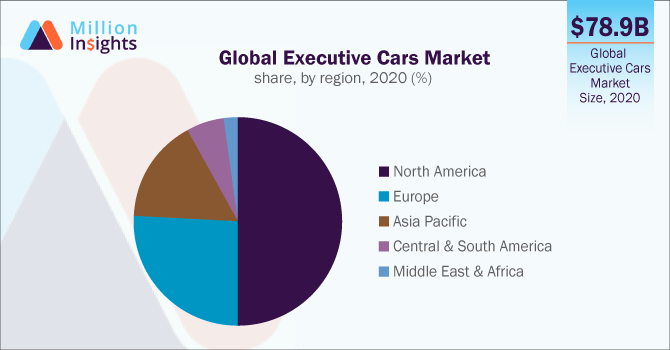The global executive cars market size was valued at USD 78.9 billion in 2020 and is expected to expand at a compound annual growth rate (CAGR) of 5.8% from 2021 to 2028. The growth of the market is significantly driven by the increasing purchasing power coupled with the rising affordability of middle-class consumers in developing countries. Executive cars are targeted at senior and mid-senior level professionals, which prominently included sedans. However, with the shift in the consumers demand to other body styles has gained popularity including, convertibles, station wagons, and coupe. Market growth is also fueled by the rising popularity of the five-door coupe, which provides the better and wider opening of the boot as well as foldable rear seats that expand boot space.

Although being expensive, executive cars offer a comfortable driving experience and raise social status. However, the industry growth is hindered by the competition from other types of cars in terms of fuel consumption, large capacity, and appearance. The growth of the market is restrained by the competition from the other passenger cars such as SUVs, sports cars, and luxury cars. Big SUV cars are enjoying increasing popularity due to higher ground clearance, sturdy and robust design, fuel efficiency, and enhanced safety. Executive cars limited new product launches, the limited production capacity of the manufacturers, and inadequate marketing have led to decreased popularity of the cars, losing sheen to the personal buyer.
The market saw a negative impact on the growth due to the Covid-19 pandemic. With the outbreak of Covid-19 and the quick spread of the infection globally, the vehicle component manufacturing industry saw a steep decline, negatively impacting market growth. As the world is returning to the pre-Covid condition due to progressive vaccination and decline in the incidence rate of infection, the auto component manufacturing, and the car market is expected to attain full recovery in the next few years.
The petrol segment dominated the market for executive cars and accounted for the largest revenue share of more than 45.0% in 2020. Conventional petrol-based executive cars dominated the market owing to long-standing and still prominent demand from the consumers. As compared to diesel and electric vehicles, petrol-based vehicles offer better services, fuel efficiency, and quick replacement parts. However, the petrol-based vehicles segment is expected to experience a decline in the near future due to stringent norms.
The electric-based executive cars segment is the most promising type and is anticipated to witness a strong growth rate of 13.4% over the forecast period. Electric cars are the most fuel-efficient, with zero air pollution, reduced greenhouse emissions, and energy-efficient. These environment-friendly characteristics along with supportive government initiatives are likely to drive the segment. Europe is leading the market for electric vehicles across the globe. However, high cost, lack of easy accessibility of services, and charging ports are the factors hindering segment growth.
Asia Pacific dominated the market and accounted for the highest revenue share of more than 55.0% in 2020. The dominance of the region in the market is mainly attributed to the increasing use of executive cars in China. In 2020, the market in China saw significant factory shipments of passenger cars, with a prominent share of sedan cars, which is the type of executive car. Additionally, the higher population of the region, contributed by China and India, is credited to the higher market share in the global market.

In Europe, the market is anticipated to register the highest CAGR of 7.1% over the forecast period. The strong presence of the manufacturing companies in the region along with the increased spending of the consumers on the automobile are credited to the higher growth rate over the forecast period. Further, the higher adoption of electric vehicles and hybrid electric vehicles in combination with the traditional ICE, as compared to the other regions also contributes to the growth rate in the market.
The market for executive cars is competitive, where key players are having a prominent role in market growth. Key players are constantly focusing on product launches and expansion to untapped geographies to maintain or increase their share in the market. New cars are enhanced in terms of functionality and appearance such as better safety, improved engine, and digital components. Such technical developments are likely to drive the market in the coming years. Some of the prominent players in the executive car market include:
|
Report Attribute |
Details |
|
Market size value in 2021 |
USD 82.7 billion |
|
Revenue forecast in 2028 |
USD 122.9 billion |
|
Growth Rate |
CAGR of 5.8% from 2021 to 2028 |
|
Base year for estimation |
2020 |
|
Historical data |
2017 - 2019 |
|
Forecast period |
2021 - 2028 |
|
Quantitative units |
Revenue in USD million and CAGR from 2021 to 2028 |
|
Report coverage |
Revenue forecast, company ranking, competitive landscape, growth factors, and trends |
|
Segments covered |
Fuel type, region |
|
Regional scope |
North America; Europe; Asia Pacific; Central & South America; Middle East & Africa |
|
Country scope |
U.S.; Canada; Germany; U.K.; France; Russia; Italy; China; Japan; India; Brazil; Argentina; South Africa; Saudi Arabia |
|
Key companies profiled |
Stellantis NV; Toyota Motor; Renault; Volkswagen; Hyundai Motor Company; Suzuki Motor Corporation; General Motors (Chevrolet); BMW Group |
|
Customization scope |
Free report customization (equivalent up to 8 analyst’s working days) with purchase. Addition or alteration to country, regional, and segment scope. |
This report forecasts revenue growth at global, regional, and country levels and provides an analysis of the latest industry trends in each of the sub-segments from 2017 to 2028. For the purpose of this study, Million Insights has segmented the global executive cars market report on the basis of fuel type and region:
Sign up today.
Call us at +1-408-610-2300 to speak with a
representative.